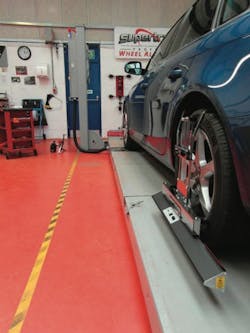European and American Wheel Alignment Markets Work Almost in Unison
While in the Akron, Ohio, area a couple of months ago I carried out a tour and summary of a number of tire retail outlets for a client in Europe to discover how the alignment market operates in North America in comparison with its European counterparts.
To be honest, looking at each market it is interesting to note similarities and differences in an industry that is universally viewed as a “money-spinner” on both sides of the Atlantic.
For example, in the U.S. I found that many customers tend to be not interested in the concept of alignment checks and do not really know what the service is all about. I was informed that around 50% of American drivers will refuse a wheel alignment check when asked by a tire technician while only 30% of European customers adopt a negative approach to the service.
Another interesting finding is that in Europe there appears to be a great emphasis to carry out an alignment check as swiftly as possible with tire centers keen to get the customer in and out of the premises as soon as they possibly can. This is because Europeans generally live their lives at full speed (all the time) and are always in a hurry so the centers tend to try and appease this full-speed attitude.
This is in stark contrast to America where customers seem to be prepared to wait longer for the alignment check to be carried out.
Price points
Looking at price levels, this appears to be on the same level in both markets although with the U.S. having larger vehicles there is a tendency to cost an alignment check on the size of the vehicle, while in Europe a price is defined by the number of adjustments required. There are also similar levels of appreciation to the value of training procedures.
Looking at both alignment markets I get the impression that America takes wheel alignment servicing very seriously while in some parts of Europe outlets just look toward getting the job done and taking the money.
Having said that I am reliably informed that it has been noticed that there is an increasing awareness by European drivers toward the importance of wheel alignment checks with a growing number actually asking about the service without being prompted.
However, there still remains a lethargic attitude toward alignment from some of the European retail centers which can carry out “shortcuts” and generally do not offer a good level of service to their customers.
In effect, companies that can appreciate the potential profit opportunities do the job properly, but some still just go through the motions without any interest. The reason for this negative approach is the cost of everything in terms of equipment dominates their appreciation and they ignore the potential increased profit margins available.
Future view
I am keeping an eye on the future and how the European wheel alignment market will develop in the short term.
Again, in speaking to a number of market leaders it seems the general opinion is that in 2016 there will be a significant advancement with the arrival of “touchless sensor technology,” whereby a tire will be instantly measured through what the inventor is calling a “revolutionary drive-on/drive-off” procedure. This means the alignment check will be even quicker than before and therefore lead to more checks being carried out every hour.
At the moment it seems there are just a few technical issues to solve which look set to be overcome, and the equipment will become available by the end of the first quarter of 2016.
Initially these highly innovative, new generation wheel alignment systems will be extremely expensive with a reported price tag of up to $60,000.
However, 3D alignment and computer alignment were also very expensive when first introduced, so in time this frightening price tag will come down.
Having seen both the European and American wheel alignment markets at work first hand I feel there is not a lot of differences in terms of equipment levels, just in their attitudes toward the service. ■
John Stone has been working within the global tire industry for the past 23 years. In 2004 he launched his own consulting company, Sapphire Media Services, which caters to business media clients around the globe. Stone also writes for tire and automotive-related publications in Europe, South Africa and Asia.
Want to read more European Notebook articles? Check out:
Taking a New, Determined Route Against Part-Worn Tires
About the Author
John Stone
John Stone has been working within the global tire industry for more than 30 years and is the owner of Sapphire Media Service, which caters to business media clients around the globe.
